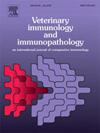Immunogenicity assessment of a swine fever-swine circovirus type 2 duplex vaccine candidate created using the Zera nanoparticle delivery method
IF 1.4
3区 农林科学
Q4 IMMUNOLOGY
引用次数: 0
Abstract
Classical swine fever virus (CSFV) and porcine circovirus (PCV) are the primary pathogens of swine fever and pig circovirus infections, respectively. Co-infections with these diseases result in severe economic losses for the swine sector. To prevent and control the disease, immunization is the primary technique for reducing co-infections and economic losses. In this work, we created a new nanoparticle vaccine using a Zera nanoparticle delivery system that expressed swine fever virus E0 and E2 proteins as well as porcine circovirus Cap proteins. We then inoculated BALB/c mice to test the vaccine's immunogenicity. The findings revealed that this nanoparticle vaccine could stimulate the mouse organism to produce high levels of humoral and cellular immunity, making it a promising candidate for the development of subunit vaccines against swine fever and swine circulatory-associated diseases. This study also provides ideas for other disease vaccines.
利用Zera纳米颗粒递送方法制备猪瘟-猪圆环病毒2型双联疫苗候选物的免疫原性评估
猪瘟病毒(CSFV)和猪圆环病毒(PCV)分别是猪瘟和猪圆环病毒感染的主要病原体。这些疾病的合并感染给养猪业造成了严重的经济损失。为预防和控制该病,免疫接种是减少合并感染和经济损失的主要技术。在这项工作中,我们使用Zera纳米颗粒递送系统创建了一种新的纳米颗粒疫苗,该疫苗表达猪瘟病毒E0和E2蛋白以及猪圆环病毒Cap蛋白。然后我们接种BALB/c小鼠来测试疫苗的免疫原性。研究结果表明,这种纳米颗粒疫苗可以刺激小鼠机体产生高水平的体液和细胞免疫,使其成为开发针对猪瘟和猪循环相关疾病的亚单位疫苗的一个有希望的候选者。该研究也为其它疾病疫苗的研制提供了思路。
本文章由计算机程序翻译,如有差异,请以英文原文为准。
求助全文
约1分钟内获得全文
求助全文
来源期刊
CiteScore
3.40
自引率
5.60%
发文量
79
审稿时长
70 days
期刊介绍:
The journal reports basic, comparative and clinical immunology as they pertain to the animal species designated here: livestock, poultry, and fish species that are major food animals and companion animals such as cats, dogs, horses and camels, and wildlife species that act as reservoirs for food, companion or human infectious diseases, or as models for human disease.
Rodent models of infectious diseases that are of importance in the animal species indicated above,when the disease requires a level of containment that is not readily available for larger animal experimentation (ABSL3), will be considered. Papers on rabbits, lizards, guinea pigs, badgers, armadillos, elephants, antelope, and buffalo will be reviewed if the research advances our fundamental understanding of immunology, or if they act as a reservoir of infectious disease for the primary animal species designated above, or for humans. Manuscripts employing other species will be reviewed if justified as fitting into the categories above.
The following topics are appropriate: biology of cells and mechanisms of the immune system, immunochemistry, immunodeficiencies, immunodiagnosis, immunogenetics, immunopathology, immunology of infectious disease and tumors, immunoprophylaxis including vaccine development and delivery, immunological aspects of pregnancy including passive immunity, autoimmuity, neuroimmunology, and transplanatation immunology. Manuscripts that describe new genes and development of tools such as monoclonal antibodies are also of interest when part of a larger biological study. Studies employing extracts or constituents (plant extracts, feed additives or microbiome) must be sufficiently defined to be reproduced in other laboratories and also provide evidence for possible mechanisms and not simply show an effect on the immune system.

 求助内容:
求助内容: 应助结果提醒方式:
应助结果提醒方式:


